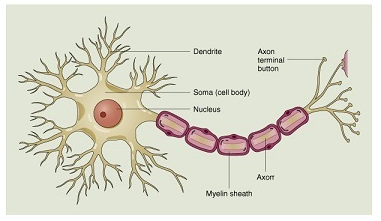Neurons
A neuron is a nerve cell which is the fundamental building block of the nervous system. The Neurons are similar to other cells in the human body in various ways, but there is one main difference between neurons and other cells. The Neurons are expert to transmit information throughout the body. The body's neurons, plus the glial cells which give structural and metabolic support, altogether compose the nervous system.
These highly specialized nerve cells are responsible for communicating information in both chemical and electrical forms. There are also numerous kinds of neurons responsible for various tasks in the human body.

Figure: Neurons
The Structure of a Neuron
There are three fundamental parts of a neuron: the dendrites, the cell body and the axon. Though, all neurons vary somewhat in size, shape, and characteristics based on the function and role of the neuron. The neuron cell body holds all the sub-cellular organelles found in a typical animal cell but it is expert for high rates of protein synthesis. The Dendrites are large extensions of cell body and receive most of neuron’s synaptic inputs. A single thin axon arises from the axon hillock. The Dendrites can produce proteins but axons cannot: axonal proteins come from the cell body. Both axons and dendrites have mitochondria. The longest axons in the human body extend from the bottom of the spine to the big toe and average a length of approximately three feet.
Classification
The Neurons may be classified by their connections, structure, and neurotransmitters. The Cells with one, two, or three or more neurites are categorized as unipolar, bipolar, or multipolar respectively. The shape of the dendritic tree, the presence or absence of spines and the length of the axon are used to classify neurons. The Connectivity distinguishes afferent neurons which provide input and efferent neurons which provide the output. The Neuron shape is frequently a good guide to the neurotransmitters and it secretes, and so to its function.